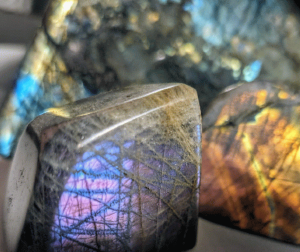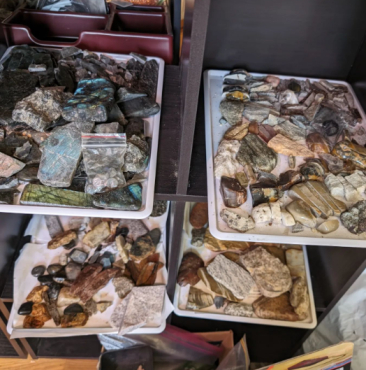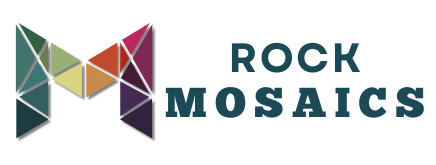
I design and make mosaics that bring nature into your home. I use lapidary tools to cut and shape rough and raw rocks, but I don’t eliminate or polish out the roughness. My mosaics are, in a way, living, since there are parts of them that may change. The copper, or the rocks that have copper in them, like chrysocolla and malachite, may oxidize. The mica and some of the more fragile rocks may crumble, so the mosaics may change over time.
Indigenous wisdom teaches us to stay closer to and pay attention to nature. Before civilization, people lived closer to nature… to rocks, sometimes even living in caves. Now our spaces are sterile. For hundreds of years people lived in stone buildings. Churches, castles and walls were made of stone. But now, many millions of people live in high-rises or housing developments devoid of stone. The mineral world, where our predecessors lived, was full of all kinds of different minerals… sedimentary, metamorphic….
Today, outside of an occasional landscape rock or aquarium stones, most people do not live in the presence of rocks. My mosaics offer a way to bring the variety, the roughness , the shaping caused by hundreds of millions of years of water, weather and erosion, to be a part of your life. I also include hundreds of millions of years old fossils and minerals that have chatoyant properties, meaning they have flashes of color, sparkle, or glow.
These are normal parts of nature, and it’s important to have them in your life to remind you what could be.
Long before I started making mosaics, one of my favorite quotations, by Ralph Waldo Emerson, has been,
“A man is like a bit of Labrador spar, which has no lustre as you turn it in your hand until you come to a particular angle; then it shows deep and beautiful colors. There is no adaptation or universal applicability in men, but each has his special Talent, and the mastery of Successful men consists in adroitly keeping themselves where and when that turn shall be oftenest to be practiced.”

That “Labrador spar” he refers to is Labradorite, one of my favorite minerals, which I use in most of my mosaics to bring in brilliant colors. Owning and regularly looking at labradorite from the different angles needed to see the “deep and beautiful colors” has led me to see the world differently, to look for and see possibilities, to recognize strengths and beauties that I have not seen before.
The Process
My mosaics start in the field, rockhounding. I choose rocks that I can envision being used in my mosaics, hopefully, really cool, beautiful ones that will add to the mosaic. So it starts with curation. I slice most of the rocks I find or buy. After slicing, I’ll pick one rock, or a collection of pieces from the same sliced and cut. Then I’ll start looking through my collection of thousands of other pieces that fit with it.
After a good start, I will add special pieces, minerals that have chatoyancy, meaning special optical effects, like flashy colors or glow, shine, or sparkle. And I’ll usually include at least one fossil that’s millions or hundreds of millions of years old. Painters have a palette using different color paints.
My palette is composed of Rocks, minerals, crystals, fossils and glass and metals Besides the rocks I find locally and in my travels, I also purchase many rocks including, agates, amber, amethyst, apatite, azurite, crystallized bismuth, chalcopyrite (peacock ore,) chrysocolla, copper, emerald, fluorite, fossils, fulgurite, garnet, gniess, hematite, jade, jasper, kyanite, labradorite, lepidolite, malachite, mica, moonstone, petrified wood, pietersite, quartz, rosy quartz, selenite, slate, smoky quartz, selenite, sodalite, sphalerite, tanzanite, tiger eye, turquoise, vivianite, and cullet glass. On all but the smallest of my mosaics, I include hanging hardware, so they don’t need a frame.
People ask me where I get my materials. I source some rockhoundin. Others I buy from eBay, from mineral, fossil and gem shows, Alibaba, and vendors I discover online or at different shows. Lately I’ve been buying from wholesalers and importers. I took my first art course, a sculpture course, when I was a student at Penn State University. In that course, I worked with welding iron, rope and epoxy, and plaster, mirror and wood.

But that was over 50 years ago. I feel blessed that, at 73, I’m enjoying the challenges of learning about lapidary arts, rock-hounding, geology, rock hardness, rock cutting, different ways to adhere mosaics, using epoxy, and identification of rocks, the art of creating mosaics, and what’s involved in taking my art and making a business of it as well.
I am also author of the book, The Bottom-up Revolution and 2500+ articles.
